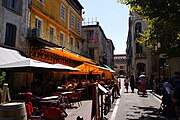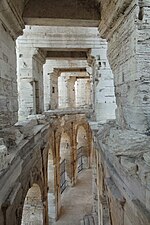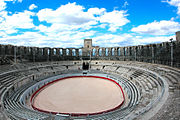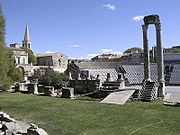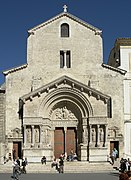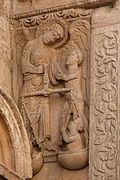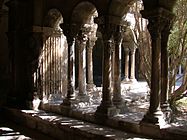Arles
| Arles | ||
|---|---|---|

|
|
|
| region | Provence-Alpes-Cote d'Azur | |
| Department | Bouches-du-Rhône | |
| Arrondissement | Arles ( sub-prefecture ) | |
| Canton | Arles | |
| Community association | Arles-Crau-Camargue-Montagnette | |
| Coordinates | 43 ° 41 ′ N , 4 ° 38 ′ E | |
| height | 0-57 m | |
| surface | 758.93 km 2 | |
| Residents | 52,548 (January 1, 2017) | |
| Population density | 69 inhabitants / km 2 | |
| Post Code | 13200 | |
| INSEE code | 13004 | |
| Website | www.ville-arles.fr | |
Arles [ aʁl ]; Occitan Arle [ ˈaʀle ], is a municipality with 52,548 inhabitants (as of January 1, 2017) in the south of France in the Provence-Alpes-Côte d'Azur region in the Arles arrondissement of the same name , Bouches-du-Rhône . With over 750 km², Arles is the largest municipality in terms of area in the European part of France.
geography
The historic center is located on the east bank of the Rhone , 24 km from the Mediterranean Sea. Arles includes a newer urban area on the west bank (Trinquetaille district) and the northern and eastern Camargue , which is why Arles is the largest municipality in France with an area of around 760 km² (for comparison: Paris 105 km²). To the left of the Rhone lie the municipalities of Raphèle, Moulès and Mas Thibert, in the eastern Camargue Le Sambuc and Salin-de-Giraud, all south of the center of Arles. In addition, there are 11 villages and numerous hamlets up to 40 km from the city center.
The Gard department begins north of the city, in Fourques on the other bank of the Rhone . The Camargue connects to the south. The large natural sandy beaches of Beauduc and Piémanson offer miles of dunes and the finest sandy beaches in an unspoilt landscape.
history
In ancient times Arles was called Arelas or Arelate (Celt. "Swampy place"), was founded by the Gauls in place of the Ligurian Theline and was founded by Gaius Julius Caesar in 46 BC. Made into the Roman military colony Colonia Julia Paterna Arelate Sextanorum .
The place soon rose to great importance, competed with Massilia (Marseille) in trade and reached its heyday under Emperor Constantine , who enlarged and embellished Arles and gave it the nickname Constantina . In 395 it became the capital of Gaul. In the year 402 the Praefectura Galliarum, the highest authority of the Roman western empire, was moved from Trier to Arles.
In Arles the Roman road Via Agrippa to Lugdunum (Lyon) and on to Augusta Treverorum to Colonia Claudia Ara Agrippinensium crossed with the Via Aurelia , which connected Massilia with Rome .
Arles became a bishopric in the 3rd century and a metropolitan seat of the Archdiocese of Arles in 400 . As the main trading point , it was subsequently conquered and destroyed several times by the Visigoths and Saracens , but it still maintained its splendor for a long time; Belonging to the Franconian Empire since 536 , it became the capital of the Kingdom of Burgundy in 879 and with this in 1033 it became part of the Holy Roman Empire . The city had been under the rule of the archbishop since 933 , became independent from him in 1220 and free and imperial city for only two years in 1237 . In 1251 the city surrendered to Charles of Anjou and in 1481 fell to France with the county of Provence . The archbishop later emigrated to Aix-en-Provence . Arles was a bishopric until 1801.
Several important Arelatic synods took place in the village : 314 against the Donatists , 354 against Athanasius , 452 to regulate church and monastery discipline , 475 against the predestinian Lucidus.
Population development
| year | 1962 | 1968 | 1975 | 1982 | 1990 | 1999 | 2006 | 2017 |
| Residents | 41,932 | 45,774 | 50,059 | 50,500 | 52,058 | 50,426 | 51,970 | 52,598 |
| Sources: Cassini and INSEE | ||||||||
politics
coat of arms
Description: In a seated Blue guardant golden lion with thrown back through the legs tail, a long-handled golden Labarum ( Christ monogram Chi-Rho) with the inscription in black capital letters cautious "CIV.AREL". The lion is also known as the Arlesian (coat of arms) lion.
Hervé Schiavetti ( PCF ) has been mayor of Arles since 2001 .
economy
The olive oil production and sheep farming in the area are noteworthy . The railway machine shops ( SNCF ), which employed around 1,200 workers up to the end of the 20th century, and the paper mill are closed. The industry is economically rather insignificant, around 2000 people are mainly employed in the chemical and food industries. The main source of income for the city, as in many communities along the Mediterranean coast, is tourism . There are also a number of publishers here and a small volume of trade is carried out through the port. The unemployment in the municipality of Arles is high and averages more than 16 percent (as of 2006)
traffic
shipping
Due to its shallow depth, the Rhône can only be navigated by smaller ships (up to 200 t ); in order to remove this obstacle to navigation , the canal from Arles to Bouc was built in 1834 and, since this was not enough, in 1864 the canal St. Louis, which is 60 m wide and 7.9 m deep, from the port of Bouc the mouth of the Rhône bypasses its bar.
South of the town of Salin-de-Giraud , the Bac de Bacarin ferry crosses the Rhône to Port Saint Louis du Rhône.
railroad
The Arles train station has long been a railway junction. In addition to the usual facilities of such a node, there was also a large railway workshop of the SNCF , which was set up in 1843. The SNCF atelier in Arles was closed in 1984.
Today mainly only the Avignon– (Arles) –Mirames – Marseille railway line is used. It was also the first to reach Arles. It was planned and built by the Compagnie du chemin de fer de Marseille à Avignon . The Tarascon - (Arles) - Saint-Chamas section was opened on September 18, 1847. The company later became part of the Compagnie du chemin de fer de Lyon à la Méditerranée , which in turn became part of the SNCF. The line has two tracks and is electrified with 1500 volts direct current . In addition, the standard-gauge route from Arles to Salon is still used by tourist trains in summer between Arles and Fontvieille . Beyond Fontvieille, it is shut down . The standard-gauge line to Saint-Louis was also closed and mostly dismantled. A normal-gauge line led to Saint-Gilles . The bridge over the Rhône was not rebuilt in 1944 after it was destroyed in World War II .
Until 1958, the narrow-gauge Chemins de fer de Camargue had its terminus in Trinquetaille , from which the line led to Saintes-Maries and Salin-de-Giraud , and via Bouillargues to Nîmes .
education
- École Nationale Supérieure de la Photographie: The city was chosen as the seat of the École Nationale Supérieure de la Photographie , the French college for photography, not least because of the influence of the local photographer Lucien Clergue (Picasso's circle of friends) .
- Hydrographic School
- Public library
Attractions
- See also: List of Monuments historiques in Arles -
Arles is one of the most beautiful cities in Provence and has numerous remains from Roman antiquity as well as noteworthy evidence of the Middle Ages.
Since 1981, many of the ancient and Romanesque monuments of the city are on the UNESCO list of world cultural heritage . The Saint-Honorat church on the Alyscamps has also been recognized since 1998 as part of the World Heritage “ Paths of the Pilgrims of St. James in France ”. Arles is the starting point of the Via Tolosana , a French section on the Camino de Santiago to Santiago de Compostela .
Ancient buildings
- Arles amphitheater , built around 90 AD; Diameter 140 m × 103 m, with two floors with 60 arcades each and offering space for around 25,000 spectators. It was expanded into a fortress in the Middle Ages, as evidenced by three square towers (12th century) and the walled arcades. At that time the whole city was inside the arena: "It was built into the arena, its outer walls were also the city walls of Arles". From 1825 the numerous houses inside and adjacent to the oval were gradually removed. It has been restored since 1846 and is currently the venue for bullfights on festive days .
- The 15 m high granite obelisk found in the southwest of the city, located in the south-west of the city, has stood on the Place de la République since 1676.
- Antique theater, under Emperor Augustus around 25 BC From which two Corinthian columns , the orchestra and the semicircular audience, the lowest of the 33 rows of seats with 12,000 seats as well as a tower that still retains the original height of three arcades, have been preserved; the famous Venus de Arles was found here in 1651 and now stands in the Louvre in Paris and as a copy in the stairwell of the Hôtels de Ville, Place de la République.
- Remains of the Roman forum with a crypto portico (around 40 BC), an underground arcade, remains of the Roman baths (4th century AD) and a palace of Constantine ; numerous sculptures that have been combined in the Musée de l'Arles et de la Provence antiques since 1995 (Dianenkopf, Medea, Apollo Altar and Arles).
Many individual pieces are exhibited in the Musée départemental Arles antique , see also the Museums section
Medieval buildings
Saint-Trophime Cathedral
see main article St-Trophime d'Arles
The most important building in the city is the former Benedictine abbey church of Saint-Trophime with its famous portal and cloister . Stones from the ancient theater were used in its construction. St. Trophimus Christianized Provence and was the first bishop in Arles before 250 AD ; his bones rest in the church that is consecrated to him. In it Friedrich Barbarossa was crowned King of Burgundy on July 30, 1178 .
The cathedral is a basilica with a 20 m high nave and has both Romanesque and Gothic style elements. While the nave, tower and facade were built in the Romanesque style in 1152–80, the Gothic ambulatory choir was not built until 1454–65. The main portal with its tympanum , which was placed in front of the west facade around 1190, is considered to be the main work of Provencal sculpture of the High Romanesque. The tympanum shows Christ as judge of the world , surrounded by the symbols of the four evangelists . The interior of the church has been modernized.
The cloister of the monastery was built in several phases between 1130 and the 14th century. In the four galleries - two Romanesque, two Gothic - all kinds of round and pointed arch styles can be found; here pillars and columns alternate with finely crafted capitals . The squares are decorated with figures, e.g. B. with a trophy figure from 1188.
In the chapter house are tapestries to see.
The portal was built between 1150 and 1200 and, along with that of St-Gilles, is considered to be the most important Romanesque portal in Provence. It is a front, gable-crowned double portal. Larger-than-life statues of the apostles stand between the free pillars on the sides. In 1998 it was cleaned.
This facility is an impressive example of the reception of antiquities in southern France in the 12th century, that is, of the return to ancient forms of design. In the case of the St-Trophime portal, for example, the facade was traditionally designed at the time and the ancient motif of a Roman triumphal arch was adopted . While the rest of the portal is integrated into the facade, it seems to have a clear life of its own here due to the pre-fading, which alone attracts the viewer's gaze. A combat frieze in relief extends over the entire lintel, showing , among other things, the twelve apostles seated. The iconographic program of the portal, but also of the cloister, with the presentation of the character faces of the sculptures, is strongly reminiscent of antiquity.
Outside the city walls
- Alyscamps ( Elysii campi , German "Elysische Felder" , in the Langue d'Oil: "Champs-Elysées") is a long avenue in front of the southeast corner of the city walls to the unfinished Church of Saint Honorat (12th century). The former Roman burial site later became a Christian cemetery. Of the numerous early medieval stone sarcophagi , only a few unadorned ones can be seen on the Allée des Tombeaux , while the most beautiful, as far as they have survived, are now in the Musèe d'Arles Antique.
- Sainte-Croix Chapel and the ruins of the Benedictine Abbey of Montmajour , one of the most impressive monastery complexes in southern France at the time, are located northeast of the city, on the border with Fontvieille .
Museums
-
Musée Réattu
- Works by the eponymous painter Jacques Réattu from the turn of the 18th and 19th centuries
- Drawings by Pablo Picasso specially created for this museum
- Newer exhibits, often photographs
- The Muséon Arlatan in the Palais de Laval-Castellane (16th century) is considered the most important collection of Provencal folklore .
- The Musée départemental Arles Antique, opened in 1995, is the Arles Museum of Antiquities. It shows and treats the history of the settlement of Arles and its surroundings from early history to the end of Roman times.
- Museum of the Camargue , open-air museum in the Mas du Pont de Rousty, about 10 km from the city center
Arts and Culture
- The beauty and elegance of the women of Arles is also famous. The Belle Arlésienne inspired Mérimée to write the libretto for the opera Carmen composed by Georges Bizet . Even Hugo von Hofmannsthal noted "the solemn Roman beauty that Kameenprofile and the royal passage" of the women of Arles.
- Vincent van Gogh : One of the (today) most famous residents of Arles was the painter Vincent van Gogh in 1888/89. During this time he portrayed Arles and the surrounding area hundreds of times. The areas in Arles that are reminiscent of his paintings were decorated for tourism in the 1990s after his paintings. A typical example of this is the Van Gogh restaurant on Place Forum (café terrace in the evening) . Because the painter was effectively driven out of the city by the bourgeoisie, the city does not own a single one of his paintings. The house he lived in on Place-La-Martine (Maison Jaune, "Yellow House") was destroyed in a bombing raid during World War II. It is true that one of the numerous drawbridges in the area inspired the painter to paint The Bridge of Langlois , but the one at the Montcalde lock, which is now signposted as the Van Gogh Bridge , is a similar one, but not the one he painted, which is round 800 m away.
Vincent van Gogh : View of Arles
Vincent van Gogh: The Night Cafe
Vincent van Gogh: Café terrace in the evening
- Pablo Picasso , who spent several years in Vauvenargues near Aix-en-Provence , was friends with the then director of the Musée Réattu . An entire floor of the museum shows - often little-known - works by the master that he created out of this constellation.
- Luma , a culture campus dedicated to contemporary art and new media, was built on the former railway site, west of the city center. Maja Hoffmann initiated the project privately with the LUMA Foundation. Frank Gehry designed the 56 m high LUMA tower. The former industrial site was redesigned by the Belgian landscape architect Bas Smets , inspired by the Arles area, such as the Camargue or the limestone chain Alpilles . The 1.2 hectare lawn is surrounded by a variety of plants and is open to the public.
Regular events
- The photo exhibition Rencontres d'Arles has been taking place since 1969 in the second week of July until the end of August and includes numerous solo exhibitions. It shows the current state of art photography.
Personalities
Sons and daughters
- Constantine II (316–340), Roman emperor
- Trophime Bigot (1597–1650), Baroque painter
- Pierre-Antoine Antonelle (1747-1817), French politician
- Victor Jean (1874–1953), lawyer and politician
- Jeanne Calment (1875–1997) achieved the longest verified human lifespan to date
- Achille Philip (1878–1959), organist and composer
- Louis Féraud (1920–1999), French fashion designer and painter
- Lucien Clergue (1934-2014), French photographer
- Christian Lacroix (* 1951), French fashion designer
- Anne-Marie David (* 1952), French singer
- Gilles Renne (* 1954), jazz musician
- Juan Bautista (* 1981), matador
- Djibril Cissé (* 1981), French football player
- Gaël Givet (* 1981), French football player
- Mehdi Savalli (* 1985), matador
- Fanny Valette (* 1986), French actress
People related to the city
- Honoratus of Arles († 430), Bishop of Arles
- Caesarius of Arles (470-542), Archbishop of Arles
- Jean Marie du Lau d'Allemans (1738–1792), Blessed Archbishop of Arles
- Paul Gauguin (1848–1903), French painter, lived with van Gogh in Arles for two months
- Vincent van Gogh (1853–1890), Dutch painter, painted and lived in Arles in 1888/1889
- Pablo Picasso (1881–1973), Spanish painter, graphic artist and sculptor, lived and painted in Arles for several months in 1912 and in the late 1930s
- Maja Hoffmann (* 1956), Swiss art collector, film producer and entrepreneur
Town twinning
-
 Fulda , Germany
Fulda , Germany
-
 Jerez de la Frontera , Spain
Jerez de la Frontera , Spain
-
 Kalymnos , Greece
Kalymnos , Greece
-
 Pskov , Russia
Pskov , Russia
-
 Sagné , Mauritania
Sagné , Mauritania
-
 Vercelli , Italy
Vercelli , Italy
-
 Verviers , Belgium
Verviers , Belgium
-
 Wisbech , UK
Wisbech , UK
-
 York, Pennsylvania , USA
York, Pennsylvania , USA
-
 Zhouzhuang , People's Republic of China
Zhouzhuang , People's Republic of China
See also
literature
- Maximilian Ihm : Arelate 1 . In: Paulys Realencyclopadie der classischen Antiquity Science (RE). Volume II, 1, Stuttgart 1895, Col. 633-635.
- (Direction Générale) Jean-Maurice Rouquette, (Direktion Scientifique) Paul Allard, Régis Bertrand, Marc Heijmans, Jean-Maurice Rouquette; ARLES histoire territoires et cultures , Imprimerie nationale Editions Paris 2008, ISBN 978-2-7427-5176-1 (The individual chapters and sections each have a noted main author)
- Celina Plag (2020): How much Paris can it be? (Arles is developing into a modern center for art and culture, where not only intellectuals from the capital like to meet. Not everyone likes that).
Web links
- Official website of the Tourist Office
- City administration website
- Entry on the UNESCO World Heritage Center website ( English and French ).
- Nicolas-Marie-Joseph Chapuy: Vues pittoresques de la cathédrale de Arles . Paris 1829 (digitized from a panel)
Individual evidence
- ↑ Statistical information on Pays Arles (PDF; 2.1 MB) , (French), accessed on August 1, 2012
- ↑ map of the railway network around Arles; ARLES histoire territoires et cultures , p. 858.
- ↑ ARLES histoire territoires et cultures , p. 860.
- ↑ PDF about the project for the further use of the area
- ↑ Dietrich Schwanitz : Education - Everything you need to know , Goldmann, Munich 2002, p. 73
- ^ Johannes Fried: Friedrich Barbarossas Krönung in Arles (1178) In: Historisches Jahrbuch Vol. 103 (1983) pp. 347-371 ( online ; PDF; 2.1 MB).
- ↑ quoted from buildings in France - Arles -
- ↑ Luma. Retrieved on August 23, 2019 .
- ↑ arlestourisme.com: Picasso
- ↑ Billionaire reinvents Arles (orf.at)





